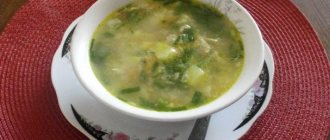Gastritis is a disease characterized by acute or chronic inflammation of the gastric mucosa.
The basis of treatment for this condition is adherence to the principles of dietary nutrition, which must necessarily include porridge. Let's talk about semolina porridge, familiar from childhood, and how to use it correctly for gastritis.
Semolina for gastritis
The list of cereals allowed for gastritis is very small. You can eat semolina porridge, corn porridge, millet porridge, oatmeal.
Semolina porridge is considered useful for gastritis, as it has:
Semolina porridge can be eaten for gastritis with both high and low acidity; this product can also be consumed during exacerbations
- effect of enveloping the stomach: this is especially necessary if there is irritation of the mucous membrane, combined with pain;
- healing effect: in some patients, cracks appear in the intestinal mucosa, which semolina can heal;
- cleansing effect: cereal has sorption properties that allow the body to rid the body of harmful substances;
- antitumor effect: this quality of semolina is especially necessary for the elderly, since at this age the risk of developing malignant pathologies increases significantly.
For gastritis, semolina porridge should be cooked in water, adding a small amount of sugar and salt. In case of exacerbations, it is better to avoid these components. For cooking you need to take 0.3 liters of water, after boiling you should carefully pour 2 tablespoons into it. semolina with constant stirring, as this cereal very quickly turns into lumps.
Cook the porridge for 5 minutes at low temperature. Sugar and salt should be added at the end. During remission of the disease, adding butter is allowed. This porridge should not be consumed daily, as it is capable of leaching calcium from cells, which is harmful to the muscular and cardiovascular systems.
How to choose the right cereal
The taste and consistency of the finished semolina depend not least on the quality of the raw cereal. Today semolina is not in short supply, as in tsarist times, and you can buy it even in the smallest store. Dozens of manufacturers offer their “most delicious” semolina, although not all of them are so. Here are some tips on how to choose the right semolina.
Today, this cereal is usually presented in two forms: packaged in the manufacturer’s branded packaging and by weight. The latter is more prone to dampness. The consequence of improper storage is a bitter or sour taste in the finished porridge. Sometimes this product may smell musty and damp. Hence the advice: when buying semolina by weight, it would be useful to smell it.
A serious danger of porridge is bugs, flies, moths and other insects that can be carriers of diseases. And having brought such uninvited guests into the house, in the future you will have to tinker for a long time to get rid of them. And porridge with “living creatures”, of course, is no longer suitable for food.
Sealed packaging minimizes the risk of mold, mildew or insects. Therefore, before purchasing, you must carefully check the integrity of the package with porridge.
Eating semolina for gastritis
The dietary nutrition of all patients with inflammation of the stomach, that is, with gastritis, requires the regular consumption of all kinds of cereals. Semolina porridge has also proven itself to be excellent for gastritis. Moreover, it is actively used in therapeutic nutrition for all those who suffer from various diseases of the gastrointestinal tract.
When consuming semolina porridge, there is a process of active healing of damage that has already formed on the mucous membrane of the inflamed stomach during the development of gastritis. Excellent enveloping effect, due to which the use of semolina porridge for gastritis allows you to get rid of many pain symptoms. It prevents not only the development of such an unpleasant process as gas formation in the intestinal area, but also the formation of low-quality tumors in it.
Porridge made from semolina is an effective means of removing waste and toxins from the human body, that is, cleansing it.
When consuming semolina porridge, there is a process of active healing of damage that has already formed on the mucous membrane of the inflamed stomach during the development of gastritis
But it is they who begin to accumulate especially actively in it due to the development of gastritis. Semolina effectively collects all those components that have a negative effect on humans from other food products.
In any case, semolina porridge is simply a satisfying dish. Therefore, a small amount of it will be required to create a feeling of fullness. It is this factor that is also extremely important for all patients with gastritis. Indeed, in this case, the normal functioning of the stomach is disrupted. Thanks to the soft and even viscous structure of semolina porridge, it will definitely not cause any harm to the gastric mucosa.
True, despite the unequivocal positive answer to the question whether semolina porridge can be used for gastritis, it is definitely worth remembering that in this case this dish is prepared not with milk, but with plain water. During an exacerbation, the addition of sugar and salt is strictly unacceptable, but in other cases it is worth adhering to minimal quantities of various additives.
In addition, if gastritis worsens, butter should not be added during the preparation of semolina porridge. But immediately after the onset of remission, you can add not only this component to the finished dish, but also some berries and even fruits. So that semolina porridge is especially healthy. When preparing it, you should make a viscous and liquid dish. Then the porridge will best envelop the walls of the stomach.
How is millet porridge beneficial and for whom?
Residents of large, polluted cities
Cereals help to quickly remove toxins and waste from the body. Therefore, it is recommended to include it in their diet for residents of environmentally unfavorable cities.
People involved in intellectual work
The high magnesium content in this product helps improve mental performance, which means it will take less time to complete tasks.
People suffering from liver and gastrointestinal diseases
The rich fiber content and the ease with which millet is digested makes this product indispensable for people suffering from these diseases.
For athletes
The benefit of millet porridge for this population group is to increase muscle elasticity, which makes training more effective. In addition, the wealth of vitamins and microelements contribute to the overall strengthening of the body.
People who have completed treatment for a long-term illness
On the one hand, there is a wealth of various beneficial substances that a weakened body needs. On the other hand, it also helps the body eliminate antibiotics, which are compounds hostile to our body.
People who struggle with excess weight
One of the main beneficial properties of millet is its lipotropic effect. This is why millet porridge is especially loved by women. Once in the body, millet prevents fats from being absorbed into the walls of blood vessels, which promotes weight loss. Plus, girls who are on fairly strict diets use millet to “get” the microelements necessary for the body.
Despite the enormous benefits that this product can bring to the body, there are times when its use, or excessive consumption, will not benefit the body. You can talk about both the benefits and harm of millet porridge. Therefore, it is worth familiarizing yourself with the general contraindications, and if in doubt, it is better to consult a doctor.
You can learn about the benefits of other cereals from separate materials:
- Pearl barley;
- Buckwheat;
- Rice;
- Manna;
- Corn;
- Barley;
- Oatmeal.
Is semolina porridge good or bad for the stomach?
Semolina is a by-product of processing dehulled wheat grains.
Cereals vary in variety and, accordingly, in the cooking time. There are three types of semolina:
- from soft wheat varieties (marked “M”);
- from durum varieties (marked “T”);
- mixed look (marked “MT”).
Semolina with the letter “M” cooks faster; a few minutes are enough to prepare it. The letter “T” indicates that this type of cereal requires more time to cook. It is this variety of semolina that is recommended for dietary nutrition when losing weight. Semolina of their soft varieties is more suitable for use as part of therapeutic and gentle diets.
The benefits of semolina porridge are not in doubt. Doctors only recommend changing its quantity and frequency of use. Semolina contains a large amount of potassium, which nourishes the heart muscle. Carbohydrates in the form of starch provide energy to the body for a long time. The iron contained in semolina improves hematopoietic function, and B vitamins have a good effect on the nervous system. Semolina is completely absorbed, without requiring large energy expenditures.
Despite all the usefulness of the product for adults, it is not worth eating it more than 2 - 3 times a week. Inflammation of the stomach - and this is what happens with gastritis - requires adherence to a strict diet, especially during an exacerbation. Eating semolina porridge is recommended for everyone who suffers from this disease.
The benefits for gastritis are as follows:
- semolina porridge envelops the walls of the stomach and promotes the healing of inflammation;
- pain goes away;
- porridge prevents gas formation and bloating, prevents the development of tumors in the intestines;
- helps cleanse the stomach and intestines.
Patients with gastritis should eat small portions. And semolina porridge will come in very handy here - it will saturate the body even with a small amount.
What is semolina: brief information about the cereal
Semolina porridge refers to coarsely ground wheat cereal. The diameter of the ground particles does not exceed ¾ millimeter. The product is rich in useful elements: vitamins of all groups (especially E and B), calcium, iron, potassium.
The composition of semolina includes:
- number of carbohydrates – 73.5;
- protein content – 11;
- fats – 1;
- energy value – 330 kcal per 100 grams.
For reference! Semolina porridge is a dietary product. The peculiarity of the cereal is its quick preparation time (a few minutes). This allows you to preserve all useful elements in the finished product.
Semolina for gastritis
Semolina porridge can be eaten for gastritis with both high and low acidity. This product can also be used during exacerbations. Semolina is the only porridge that is digested in the lower intestine and is immediately absorbed into its walls. Porridge cleanses the organs of mucus and removes accumulated fat.
Semolina porridge is not prohibited for consumption with gastritis if it is prepared without the addition of fat milk, butter, large amounts of sugar and other non-dietary impurities. In turn, this dish will help restore damaged gastric mucosa, reducing cracks, wounds and ulcers formed as a result of long-term gastritis.
It is best to introduce semolina porridge gradually and consume it no more than 3-4 times a week, alternating with other dietary dishes (soups, steamed vegetables, boiled fish).
Semolina porridge is not prohibited for consumption with gastritis if it is prepared without adding full-fat milk, butter, large amounts of sugar and other non-dietary impurities
Nutritionists recommend semolina during the recovery period after exacerbation of gastritis, viral, and a number of infectious diseases. It is allowed to add honey, butter, nuts, dried fruits and berries to the dish.
Semolina porridge for gastritis with high acidity should be prepared with water or low-fat milk. Adding sour berries and fruits to the dish is prohibited. It is better to replace sugar with a small amount of honey. It is advisable to serve semolina porridge warm in small portions.
An obvious advantage is that semolina porridge is easy to prepare. It goes well with jams, fresh berries and dried fruits. If you eat the dish for breakfast, the toxicity of products entering the gastrointestinal tract after breakfast will decrease. Despite the benefits of semolina porridge, it is quite high in calories, so it is not suitable for those people who are struggling with excess weight.
Semolina porridge can be a real assistant in the treatment of gastritis, provided it is prepared correctly. Despite this, the dish should not be regarded as a substitute for prescribed medications that have analgesic, enveloping and anti-inflammatory effects.
Guryevskaya porridge
There is another version of semolina porridge, which compares favorably with the usual semolina from the school canteen. This is a nice Guryev porridge. Its recipe appeared at the beginning of the 19th century, when semolina was only a delicacy for the bourgeoisie. So, the then financial minister of the State Council, Count Guryev, once visited his comrade Major Yurisovsky. The latter, knowing about his friend’s passion for delicious food, ordered Zakhar Kuzmin, his serf cook, to prepare something like that in order to surprise the count. And the cook prepared semolina porridge with nuts, dried fruits and creamy foam for dessert. They say that after the meal, the count bought the serf for an amount unimaginable at that time and made him his personal cook, and the porridge has since been called Guryev’s [8].
Is it possible to eat semolina for gastritis?
https://youtu.be/vS_SS9Xo1ws
Since semolina does not affect the production of gastric juice, it is allowed to be included in the diet menu for gastritis, regardless of the type of secretion disorder - it will be useful both with high acidity and with a reduced pH level.
Semolina also finds its use in the erosive form of gastritis - it envelops the affected walls of the stomach and activates regeneration processes, promoting the healing of mucosal defects and a speedy recovery. The adsorbing effect of semolina is useful for chronic gastritis. Constant low-grade inflammation contributes to the accumulation of toxins and other harmful substances in the digestive tract, and cereals help remove them from the body.
Cooking semolina porridge for gastritis has the following principles:
- in the acute period of gastritis, porridge must be prepared exclusively on a water basis;
- as the acute inflammatory process subsides, it is allowed to cook the porridge in milk diluted with water in a 1:1 ratio;
Since semolina does not affect the production of gastric juice, it is allowed to be included in the diet menu for gastritis, regardless of the type of secretion disorder
- during the remission period, in the absence of contraindications, whole milk can be used as a basis for porridge;
- the use of salt and granulated sugar is recommended only for the chronic form. During the remission period, fruits are allowed to be added to the porridge. For high acidity, you can use apples and bananas; when low - oranges, tangerines, pineapples.
It is recommended to eat porridge for breakfast. It should be included in the menu no more than three times a week.
How to choose the right semolina
First of all, you need to pay attention to the shelf life of the cereal - it should not be more than nine months from the date of production; A longer time indicated on the packaging indicates that the semolina has been chemically treated. Typically, packages of cereals are marked with the letters “T” and “M”.
For patients with various forms of gastritis, it is preferable to choose semolina with a “T” - this means that it was made from durum wheat. Since most cereals are packaged in transparent bags, you can easily see them: semolina should not contain impurities and be white-cream in color. Before cooking, it is important to check the cereal by touch - it should be dry and not stick together into lumps.
Gastritis and its manifestations
Nowadays, a large number of people complain about gastritis, because it is not for nothing that it is considered a disease of the 21st century. This disease is caused by eating fatty, spicy, salty and fried foods, smoking, alcohol, unbalanced diet, food poisoning and viral bacteria. Gastritis is a disease that is accompanied by inflammation of the inner lining of the stomach and severe pain in the stomach after eating. The pain can be cutting, burning or sharp, sometimes accompanied by a temperature of up to 38 degrees. If you have belching, accompanied by an aching or pulling sensation in the stomach, mild nausea, heartburn - these are the first signs of gastritis. The presence of gastritis in your stomach is also indicated by the presence of a solid white coating on the tongue and bad breath. With increased acidity, a sour smell appears, but if you eat foods high in protein, it will smell like something rotten. The danger of this disease is that if you do not consult a doctor in a timely manner and begin treatment, it develops into an ulcer, and then into oncology.
Remember that oats for gastritis are just an addition to the main treatment, although quite effective.
How to properly cook semolina for gastritis
Before cooking, it is important to know the main feature - semolina porridge for patients with severe gastritis, which threatens the formation of stomach ulcers, is prepared not with milk, but with purified water. It is allowed to add a pinch of salt and sugar in case of chronic illness (do not add during exacerbations).
If there are no special instructions from the attending physician, it is allowed to cook semolina with milk. You need to cook porridge at the rate of 300 g of cereal per liter of liquid. Cook in milk for no more than 2 minutes, remove from heat and cover with a lid. Leave for 15 minutes - during this time the cereal will swell to the desired viscosity.
During exacerbations of gastritis, all additives (including sugar, salt and oil) are prohibited. After the onset of remission, you can add berries or fruits to the semolina: for low acidity - apples, pears, cherries; for elevated levels – bananas.
Take 2 tablespoons of semolina porridge. Gradually pour the cereal into boiling water, stirring constantly
When preparing, it is important to achieve a viscous and liquid consistency - this will help to have a more effective enveloping effect on the walls of the stomach. Do not get carried away with eating semolina - excessive consumption provokes the appearance of excess weight.
Semolina porridge with water for gastritis recipe
Pour 300 ml of water into the container. Place on the stove, after boiling, reduce the heat. Take 2 tablespoons of semolina porridge. Gradually pour the cereal into boiling water, stirring constantly (this will prevent the formation of lumps). We continue to stir the porridge throughout cooking - this will ensure a uniform consistency. Cook the semolina for 4-6 minutes over low heat.
After cooking, add sugar/salt and mix thoroughly. If there is no exacerbation, add a little butter (you need to melt it first). You need to eat cooled porridge (warm, but not cold).
Recipes for you
Semolina porridge can be liquid and viscous. It depends on the ratio of cereal and water. For gastritis, the following recipes are allowed:
Liquid
- Take 0.5 liters of milk and 3 tablespoons of semolina.
- Bring milk to a boil.
- Gradually pour the cereal into the milk, stirring gradually.
- Add a spoonful of sugar.
- Cook for five minutes, remembering to stir.
Manna
To prepare it you will need the following ingredients:
- powdered sugar;
- vanilla – 1 tsp;
- semolina - 4 tbsp. l.;
- baking powder – 0.5 tsp;
- butter - 100 g;
- sugar – 100 g;
- kefir -250 ml;
- 2 eggs.
To prepare manna, you need to beat eggs with sugar. Separately, pour semolina with kefir and let it brew. After combining the mixture with eggs, add vanilla and butter.
Pour the mixture into a baking dish and cook in the oven for half an hour at 180 degrees .
At the end, sprinkle the cake with powdered sugar, but you can do without it.
Cooking semolina porridge in water for gastritis
Decide in advance who you will be making the dish for, namely for small children or adults. Choose the right semolina variety based on point one. It is better for kids to prepare thinner porridge so as not to burden their stomachs, but thick porridge is more suitable for adults. The degree of thickness depends not only on the correct consistency of the liquid and cereal, but also on the variety. Larger semolina produces a thicker dish, while smaller semolina produces a thinner consistency. Prepare cereal at the rate of 1-2 servings at a time.
The process of preparing semolina in water is a little simpler than in milk. When milk starts to boil, it often burns to the pan, while water is not so tricky and does not require thorough stirring, but you still have to stir.
Stir semolina when cooking in water with a wooden spoon; the porridge sticks to it less. Don't be afraid to experiment with adding fruit to your semolina recipe. Porridge cooked in water has a bland taste and you still have to add sugar to it, and along with sugar you can add something else (raisins, dried apricots, nuts, jam, etc.).
Stir semolina when cooking in water with a wooden spoon; the porridge sticks to it less
Barley porridge: vitamins and minerals
It is worth immediately noting that the cereal is made from barley. Therefore, it has almost all the same beneficial microelements and vitamins as barley. Like other cereals, barley has vitamins:
- Group A. Vitamins of this group improve vision, have a positive effect on the skin, and also strengthen the immune system.
- Group B. Necessary for the normal functioning of the nervous system, participates in supplying brain cells with useful substances, and normalizes sleep.
- Group E. Responsible for the operation of biochemical reactions.
- PP groups. A valuable vitamin for blood circulation in the body, prevents skin diseases.
- Vitamin D. The vitamin is especially useful for the skeletal system and musculoskeletal system. Helps absorb calcium and is responsible for bone strength.
Barley groats contain the following microelements:
- Silicon;
- Calcium;
- Potassium;
- Magnesium;
- Manganese;
- Iodine;
- Zinc;
And other useful microelements that you simply can’t count.
Energy value of barley groats:
- 324 cal.
- Proteins – 10-11 g;
- Carbohydrates – 66-67 g;
- Fats – 1.3-1.4 g.
One hundred grams of cereal contains as much as 324 kcal. This is one of the highest calorie cereals. This information will be useful to know for those who play sports. It is difficult to find a more high-calorie porridge. And calories are valuable energy that does not allow you to burn muscle tissue during training.
The egg is also useful for those losing weight. Despite its high calorie content, it is much better digestible than pasta. Thus, the energy received is spent on vital activity, and not on fat reserves.
Storage
The cereal should be placed in a dark, dry place. The temperature should be between 5-20 degrees, and the relative humidity should not exceed 65%. At temperatures from -5 to +5, semolina is stored for up to 8 months, and at +21 - up to 90 days.
It is better to keep cereals in glass jars with plastic or metal lids. Containers designed for bulk products, as well as bags made of natural fabric, ceramic, earthenware, and clay containers are suitable. Proper storage ensures long-term preservation of the product.











